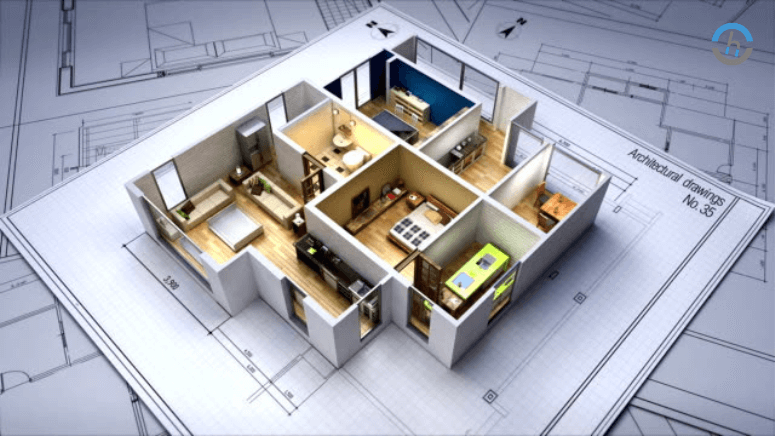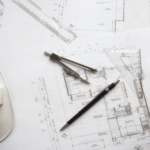A floor plan layout is a technical drawing prepared by an interior designer as part of construction documentation. A bird’s eye view of the property shows the structure without the roof.
The simplicity of the floor plans allows potential buyers and investors to get an insight into the subtlety of a property’s spaces and how they interact with the other parts of the house.
These layouts, irrespective of whether they are 2D or 3D, provide the location of doors, windows, and walls.
Whereas interior design drawings are aimed at outlining the general setup of the whole property, floor plans are to be used to show the built-in components like bathroom outfits, kitchen units, and different wardrobes located in other rooms in the property.
Interior design is an odd mix of creativity and practicality, in which the order of the day is almost as important as art.
The floor plan layout is a pallet on which all the design decisions, such as colours and textures, will be based. Whether you’re trying to fit your big dining table into a tiny space or planning a two-story living room, the geometry of the floor plan tells it loud and clear. To architects, designers, and interior design aficionados, knowing about the differences in specific floor plans is indispensable. Close up to the universe of floor plan formats and how they shape people’s dwell areas.
Importance of Floor Plan Layouts in Interior Design
Floor plans for interior design are the same as blueprints for construction – both are visual representations of how the space is organize. With a thoughtful layout, flow is optimized, organization is promoted, and function is boosted.
The combination of these factors lays the foundation for a balanced living space. They are the translators of the architect’s vision, serving as a critical tool for builders and clients to follow.
Floor plans are not just about beauty. It also has a more profound objective. From the placement of walls to the choice between an open-concept or divided layout, each detail, however small it may seem, can strongly affect the way a space can utilize.
The Benefits of Various Designs of Floor Plan Drawings
There are diverse 2D floor plan drawing designs that can be significant assets to us to improve our daily lives and social interactions. The features such as space layout and circulation of the living space can improve functionality, create good flow, and provide different atmospheres that meet various lifestyle needs and preferences.
Every decision regarding design deals with what people want their home to be and how they want it to look like, as it translates to the owners’ needs and style.
Enhancing Spatial Visualization
It is a carefully laid out floor plan that allows spatial imaging so designers and clients can visualize the final design in great detail. It becomes a frame, limiting the lighting, colour, and surface texture within that particular space.
Optimizing Functionality
Maximum function is the elixir of interior design, and the floor plan layouts are the protectors of this. Room, hallway and common area locations can be smartly put together in such a way that the daily activities can be streamlined and a comfortable flow is created throughout the space.
Adapting to Diverse Lifestyles
The intended floor plan designs serve varying styles of living. Parents might find an open plan layout more attractive because it invites family togetherness, but career-oriented singles could be eager to have an in-house office plus a gym to work out.
Although designs of floor plans are generalized and prescribed by governments, individualized layouts can be customized with such unique needs in mind. This creates a residence that is exclusively crafted for those who will be dwelling in it.
Common Types of Floor Plan Layouts
By examining layouts of different floor plans, we point out the particular uniqueness of specific designs, one of which is based on an open concept and some on a more fragmented traditional design.
Single-Floor Layouts
In short, ranch homes are also named single-floor layouts; hence, they are characterized by easy walkability and usability. These homes fit best for families with young children or for aged people with limited mobility as they are accessible by stairs.
Multi-Level Layouts
An assortment of spatial solutions with different levels of diversity of application is a catalog of exciting and functional choices. In the case of more prominent families, designing the upper and lower floors separately can give a chance for privacy and equilibrium; common areas can be on the ground floor, while bedrooms can be on the first floor.
Open Concept Layouts
Open concept layout that boasts being open in space is one of the trending styles and is loved by all. It finally reduces the barriers between living, dining, and kitchen, thus enabling community to easily socialize and entertain their guests.
Galley Layouts
It is essential to remember that galley-type design is mainly suited to apartments or tiny homes. The allowance of a straight path opens off directly in between the kitchen and service areas. This style sometimes serves as a lightweight replacement for long sentences as it mixes well with the nature of minimalist aesthetics.
L-Shaped Layouts
The L-shaped floor plan caters to small and large homes for various living conditions. The unhurried course of these elements is then channelled by the angling of the layout, which creates visual interest and allows for the smooth allocation of different uses.
U-Shaped Layouts
The U-shaped plans girt a central court so that plants, humans and animals alike benefit from the possibility of being in one with the courtyard. The layout is devised to be suitable for larger lots, with plenty of light and a way for you to incorporate a suitable landscape around your home.
Interior Drawings: Types of Floor Plan Layouts
The interior drawings are the designers’ plans in a box, so they are minimally fabricated, which is further defined in the context of the given space.
Wall Layout Drawings
Such layout is the key to all floor designs. The floor plan reveals the structure of walls with load-bearing sides, which are very important for building interiors.
The process of some advanced plans also includes wall mounting and dismounting positions for renovation, plus partition plans for interior remodeling.
Door Windows and Layout (Drawing)
As a part of this layout, doors and windows are also positioned according to the general main layout options. At other times, they appear singular on a standalone drawing, only to be distinguished more.
Such floor plan drawings also illustrate how the doors and windows will open directly or whether they will be fully or partially along.
Alongside these drawings, the measurements of doorway and window holes are also mention in a homogenous fashion for calculations. This information lets interior designers select the correct fitting of glass, the materials to comprise, and window frames.
Plumbing Layout Drawings
One with a plumbing design is also part of a standard floor plan. It comprises all devices on a given property, including showers, bathrooms, sinks, and toilets.
In some projects that involve the necessity of significant remodeling or construction work, the layout becomes the diagram of the piping system.
Electrical Layout Drawings
These floor plan drawings in the electrical and lighting circuit scheme include the layout of wires, devices, and units and the location of all light sources, switches, and output sockets required for an innovative and effective electrical and lighting system in the property.
The development of electrical systems includes a concealed electrical layout, embedded cables, and transformers placed at different locations in the room. Electrical installation drawings are necessary for construction as well as renovation of old buildings. They are of great value to the professionals in this area.
Also read: Guide For Electrical Drawing Services 2024
Furniture Layout Drawings
Although it is not a part of the construction drawing or design of architecture work, the furniture layout drawing is a crucial part of interior design drawings. These plan layouts represent the simplified top view of furniture and their location, size, and shape.
By using furniture design drawings, visitors can visualize the furniture layout and the amount of free space there is in a room.
Considerations for Different Projects
It is essential to ensure the floor plan layout designs are project-specific to achieve the excellence the project deserves. Rural projects applying for a permit will be different than urban ones in the main and within them, unique features are present that must dealt with separately.
Integrating Design Elements
Floor plan layouts are the preliminary stage for designers and aesthetic decorations to appear. If it’s simple, even though it could have a more flashy, authentic touch, the layout should allow designers to have only calmness and peace of mind, not less but more.
Environmental Impact
Nowadays, when discussing design, sustainability is of great importance. Plans have to use low-energy lighting, air conditioning, and other systems fitted to the highest standard.
Also read: What are 46 Types of Construction Drawings?
Leveraging Technology in Design
These days, with the aid of technology, the design process is no longer restrict. Digital tools provide perfect precision; they significantly increase the speed of design iteration and lay an innovative graphic basis that increases the client’s comprehension rate.
Digital Tools and Software
In addition to AutoCAD for detailed models, the available digital tools and software are excellent, and they have made radical changes in how plans are executed and demonstrated.
3D Modeling and Virtual Reality
3D models and VR platforms will give a whole new meaning to the demonstration of design concepts. Please add a caption for this image that goes beyond the title and credits. Clients can now experience “touring” through the existing space before any construction or remodeling has begun to help ascertain what is needed and generate excitement for the final design.
Choosing Outsource Interior Drawings Services
Choosing an outsourcing interior designing service may be profitable for you as you will be able to save not only on costs but also gain access to expertise in this field. When selecting a service provider, it’s crucial to consider factors such as: When selecting a service provider, it’s critical to consider factors such as:
- the provider’s portfolio and experience in interior design drawings
- the tools and technologies they use
- their communication and project management processes
- the level of customization offered for floor plan layout designs
Chudasama Outsourcing, a prominent global company, specializes in offering premium outsourcing CAD drawing and Interior 3D Rendering Services that cater to diverse client needs with a focus on innovative design solutions and exceptional quality.
Conclusion
The analysis of a floor plan layout of interior design is not only the artistic side of the issue but also interdisciplinary. Without it, the room plan will collapse, like a building without a foundation. A floor plan synthesizes the whole project, creating a closed structure on which the design is focus.
The comprehension of the types of layouts and how they influence the designing process can help architecture and interior design experts, as well as teach homeowners, unlock the full potential of every piece of space around them. It is similar to an entrée to modernize, work in collaboration, and breed thoughts that remote possibilities exist in interior designing.




